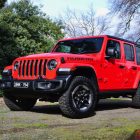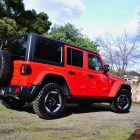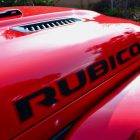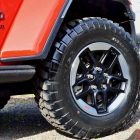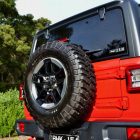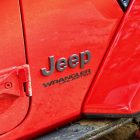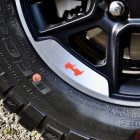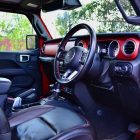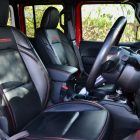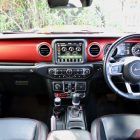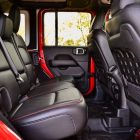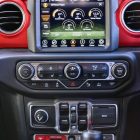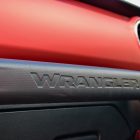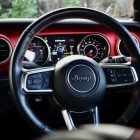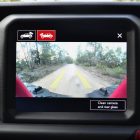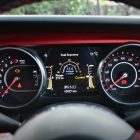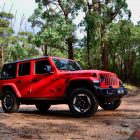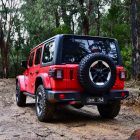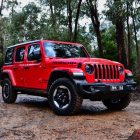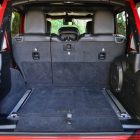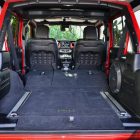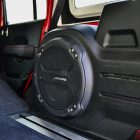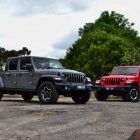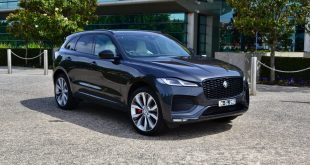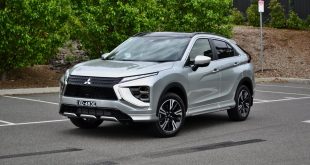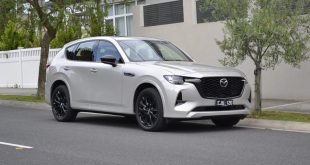For over 60 years, the Jeep Wrangler has been synonymous with freedom. The iconic go-anywhere, do-anything four-wheel drive has its roots back in the mid-1940s, where it was used as a rugged transporter for the U.S. military in World War II. Produced by Willys, it was known as the General Purpose vehicle, or in short GP vehicle. Say the acronym GP quickly and it will sound like ‘jeep’, which was how it was called later on and also how the Jeep brand got its name.
While the modern Wrangler has evolved significantly from its military ancestors, many key areas remain faithful to the concept of the original GP vehicle. The body-on-frame design, live axles at the front and rear, flat windscreen and flared boxed fenders are still used by all Wrangler models today. Even the removable doors and hard or solf tops are all inherited from the military vehicle.
Over the decades, much effort has been made to make the Wrangler more appealing to daily drivers both in styling and comfort, but there’s no mistaking its utilitarian design. The two-box shape has defined the Wrangler for over four generations. It’s become one of the most recognisable vehicles on the road today.
The current model has been around since 2018, with periodic updates keeping it fresh over the years. In Australia, the three-tier line-up kicks off with the Night Eagle at $74,950, progressing to the Overland at $80,450, and topped off by the Rubicon at $83,950. All prices exclude on-road costs.
On test was the Wrangler Rubicon in Firecracker Red and it was quite a sight to behold. On today’s SUV plague roads, this vibrant red four-wheel drive stood out everywhere it went during our week-long test. There were admiring looks from bystanders and ute drivers alike, understandably because one’s thoughts are immediately taken to some sort of remote wilderness at the sight of a Wrangler. This thing spells adventure like no other.
How could it not? The Wrangler has one of the most capable off-road underpinnings of any 4X4, matched by superior ground clearance and a ruggedised interior. Look around the Wrangler and it’s clear that from the outset this vehicle has been designed with off-road intent at its core.
The cabin is interesting. From the layout of the dashboard to the design of the switches, it’s as close as you could get to something Dwayne Johnson would drive in a set of Jumanji. Oh wait, he did drive a Jeep in Jumanji. Anyway, the interior design is all off-road focused. There are plenty of exposed screw heads and chunky handles in the cabin. The roof extends out further than that of a passenger car to give you more shade – which is why the A pillars are almost vertical. The power window switches are located in the centre console rather than in the doors so they don’t get wet in deep water crossings. The USB ports and media jacks have plastic flaps over them for the same reason. There are even drainage plugs under the removable carpets!
Compared to previous generations, cabin materials have stepped up a notch, with hard plastics in many areas replaced with softer types. The red leather stitching on our Rubicon tester is also much neater than before. Build quality is still questionable in some areas though. The plastic covers in the B pillars especially, are flimsy. The glove box fell off almost every time it’s popped open, due to it being supported only by a thin piece of plastic when open.
The Wrangler’s boxy passenger compartment yields reasonably generous headroom and legroom. It sits five adults with ease, though for our right-hand-drive version the driver’s foot well is partially impeded by a bulge from the transmission housing and so there isn’t a foot rest for your left foot. The front seats offer good support and the rear bench is wide and spacious – if not a little flat. Unlike the front there also isn’t a driveline hump impeding rear legroom. Boot space is massive at 898 litres, which is great for packing up your suitcases, camping gear and sporting equipment for that weekend away in the bush.
As mentioned before, all doors, roof and rear section are removable. The roof can be removed easily in minutes with the release of latches, but taking off the doors and rear section require removing some bolts with a special tool (supplied). Once everything is off, the entire interior is revealed and you’re good to go – Night Safari style. Beware though as it’s illegal to drive without doors in Australia!
While the open-air cabin is truly open, it’s assuring to know that occupants are still protected by a built-in roll cage, so if you do roll you should be able to climb out relatively unscathed. The Wrangler is probably safer in any low speed tip over than in a high speed crash, as it has only four airbags – all of them for the front occupants. The lack of regard for rear passenger safety is questionable in this day and age. This is also why the Wrangler scored only a three-star safety rating.
Complementing the passive safety features, or the lack of, the Wrangler has stability control, forward collision warning, automatic emergency braking, blind spot monitoring, rear cross-traffic alert, roll mitigation and reverse view camera.
In terms of entertainment and connectivity, the Wrangler gets an 8.4-inch touchscreen running the brand’s intuitive UConnect infotainment interface with built-in satellite navigation, wired Apple Carplay and Android Auto connectivity and DAB+ digital radio. The 9-speaker 552-watt Alpine premium sound system is great, with surround sound coming from the overhead sound bar and punchy bass served up by the boot-mounted subwoofer.
The job of hauling the near two-tonne Wrangler falls to Jeep’s familiar 3.6-litre normally-aspirated petrol V6 engine that produces 209kW @ 6400rpm and 347Nm @ 4100rpm. It’s widely used in a range of models within the Fiat Chrysler Automobile (FCA) group of brands. Although it’s getting a bit long in the tooth now, the V6 still does a decent job around town, on the highway and off the beaten track.
With down-sized turbo and hybrid the norm these days, atmos V6s are getting rarer and so the linear power delivery and immediate throttle response of the V6 is kind of rewarding. With no turbo lag or electric assistance trickery to deal with, what you get is tractable V6 power from the get-go and right through to the limiter. Matched with a smooth-shifting torque converter eight-speed automatic transmission, the sprint from rest to 100km/h takes just 7.9 seconds (claimed) – no slough considering the vehicle’s heft.
While the powertrain is a relatively refined unit, the rest of the car isn’t so much. The 32-inch BFGoodrich off-road tyres are noisy and rough on tarmac, and the squared off body and large side mirrors create quite a lot of wind noise at high speeds. Those uninsulated roof panels don’t help either in keeping noise out or absorbing cabin noise.
The steering is vague on road, which makes keeping the vehicle straight at highway speeds quite a challenge as you have to constantly make steering corrections to keep within the lane. The turning circle is also large, making three-point turns a nightmare.
Ride comfort has certainly improved over previous generations, with bad roads smoothed out much better than before, but don’t expect it to deliver the kind of plush ride you get in crossovers or conventional SUVs. With those hard off-road tyres, there’s still an element of roughness to it.
That said, no one buys a Wrangler for road manners. This thing comes into its own element as soon as it hits the gravel. It transforms into the ultimate off-road machine. The Rubicon model tested here builds on the basic Wrangler’s already capable off-road credentials with a host of hardcore dirt-kicking goodies, including locking front and rear Dana 44 heavy-duty axles, electronic sway bar disconnect for maximum wheel articulation, Rock-Trac 4:1 low range transfer case with crawl ratio of up to 77:1 and steel off-road rock rails.
These features are on top of off-road essentials like high-range 4WD, hill-descent mode, winch-capable steel bumpers and underbody steel skid plates. The front and rear overhangs are short to allow for such steep approach and departure angles of 36.5 and 31.9 respectively. Few off-roaders can boast those figures.
It was soaking wet on the day we took it off road, but the Wrangler was happy to tackle just about any terrain that lied ahead. Traction was remarkable as all four wheels maintained constant contact with the ground thanks to the huge suspension travel. The locking differentials did a fantastic job pushing the Jeep over any crest or rocky terrain. There’s seriously very little that this thing is not able to plough through.
Back on the black top, the 3.6L V6 is not the most efficient mill out there. With so much drag from the upright body shape and high rolling resistance from the tyres, the average fuel economy at the end of our week-long test was an unimpressive 12.5L/100km. Granted, it does have a large fuel tank at 81 litres so it can travel the distance when filled up and it only needs regular unleaded 91RON fuel.
Verdict
Design & Comfort
Performance & Handling
Quality
Economy
Equipment & Features
OUR SCORE
3.8/5
+ Plus
- Iconic rugged looks
- Incredible off-road capability
- Open-air cabin
– Minus
- High road and wind noise
- No rear passenger airbags
- Some build quality issues
Overall
Picture this: on a nice sunny day, rolling away in the Wrangler to your favourite scenic route with the top down, then turn off onto the beach, drive along and get off to do some surfing. This is what the Wrangler is all about – a freedom machine that blends into your life. Despite its many shortcomings, the charm, character and joy that it brings is hard not to like.
2022 Jeep Wrangler Rubicon pricing and specification
| Price (Excl. on-road costs): | From: $83,950 As tested: $89,675 Fitted options:
|
| Warranty: | 5 years/100,000 kilometers |
| Warranty Customer Service: | 5 years roadside assist |
| Country of Origin: | United States of America |
| Service Intervals: | 12 months/12,000km |
| Engine: | 3.6-litre V6 petrol: 209.0kW @ 6400rpm, 347Nm @ 4100rpm |
| Transmission: | 8-speed automatic |
| Drivetrain: | Four-wheel drive |
| 0-100km/h (seconds): | 7.9 |
| Combined Fuel Consumption (L/100km): | Claimed: 10.3 Tested: 12.5 |
| RON Rating: | 91 |
| Body: | SUV, 5 seats |
| Safety: |
|
| Dimensions (L/W/H/W-B) mm: | 4,882/1,894/1,848/3,008 |
| Ground Clearance: | 252 |
| Tare Mass (kg): | 1,992 |
| Boot Space (L): | 898 |
| Towing Capacity (kg): | Braked: 2,495/Unbraked: 750 |
| Entertainment: |
|
 ForceGT.com Car News, Car Reviews, Video Reviews, Tuning and much more.
ForceGT.com Car News, Car Reviews, Video Reviews, Tuning and much more. 